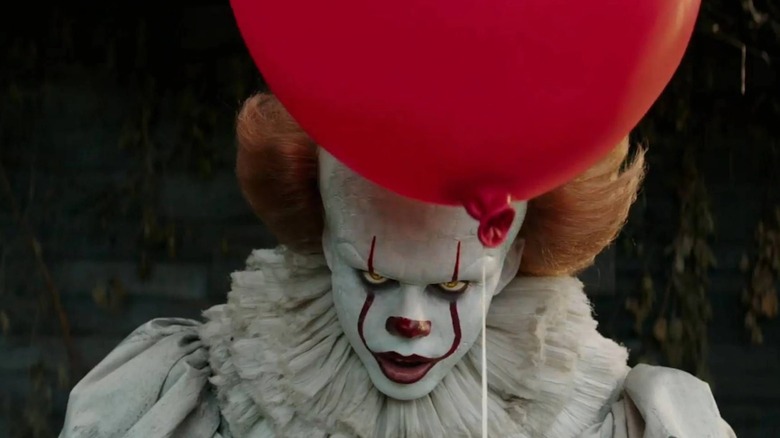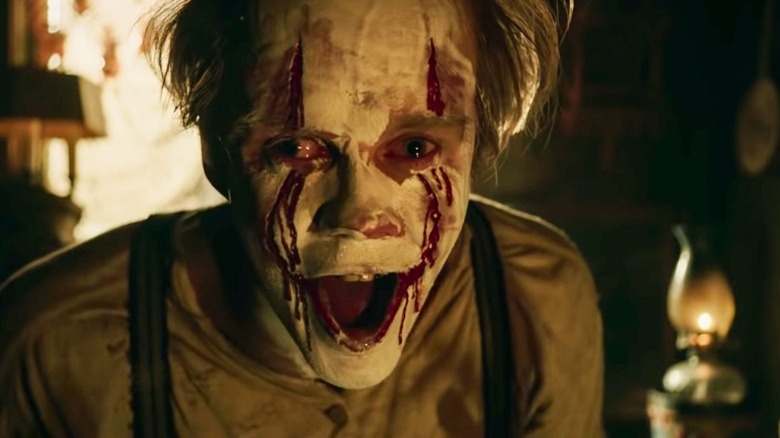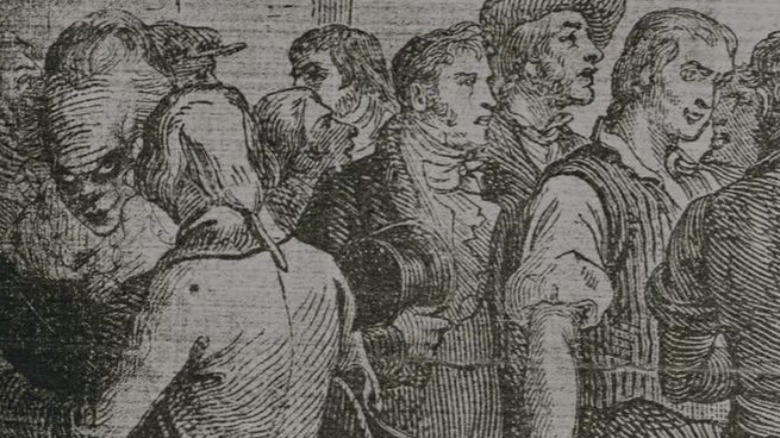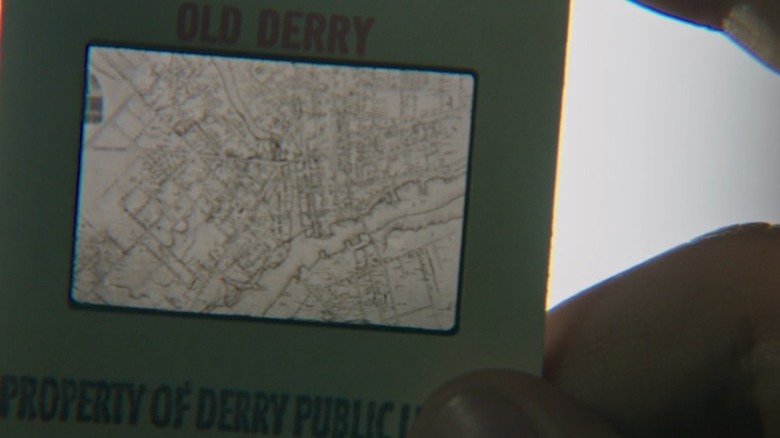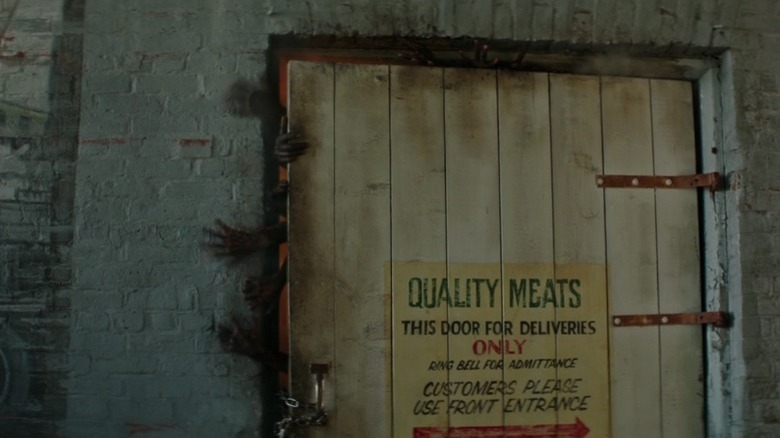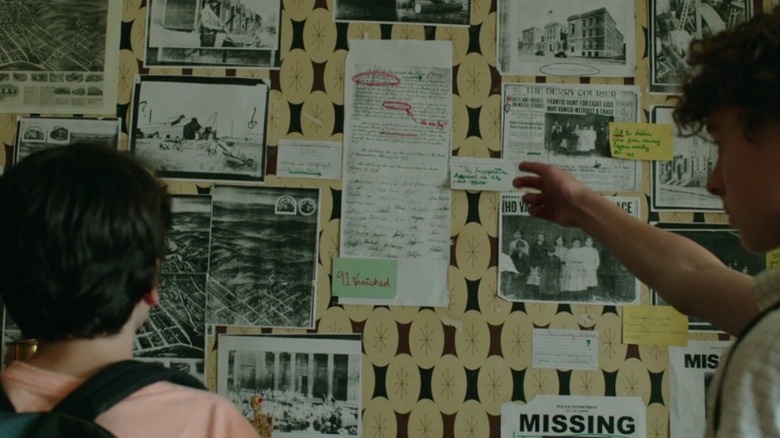What We Want To See In The It Series
When news dropped in March that an "It" prequel series may be headed to HBO Max, the announcement opened the floodgates of speculation for fans of one of Stephen King's scariest — and heftiest — books. Variety reports that the series, which is currently called "Welcome To Derry," will be largely set in the 1960s, but will also dig into the origins of Pennywise the Clown. The prequel series will be developed and executive produced by Andy Muschietti, who directed both recent adaptations of the beloved book.
With over a thousand pages of source material to pull from, "Welcome To Derry" could pretty much be about anything — except the Losers Club. In Muschietti's timeline, the group of foul-mouthed kids turned world-weary adults led by Bill Denborough (played by both Jaeden Martell and James McAvoy) already bested Pennywise for good in 2016, so this series will likely pull from Pennywise's greatest hits throughout history. There are plenty of deep cuts in his catalog to choose from, but here are a few that would be especially terrifying to witness on the small screen.
The creation of Pennywise
Muschetti's films hint at the creation of Pennywise, but viewers never get to see the evil force's creation in all its horrifying glory.
In King's book, the creature rockets to earth on an asteroid, landing in the prehistoric land that would eventually become Derry, Maine. There, It seemed to go mostly unnoticed for years, with its earliest recorded appearance happening a few centuries before the Losers Club came along and knocked It out of commission. In "It: Chapter Two," viewers caught a glimpse of one prior version of Pennywise, a dapper but frightening man glimpsed in flashback, and in the photo found by Jessica Chastain's Beverly at Mrs. Kersh's house.
It makes sense that Muschietti didn't dive headfirst into the creation of Pennywise in either "It" film, as it's actually a complicated cosmic event with ties to other King books like "The Dark Tower" series. Pennywise seems to be counted among a group of beings that initially exists in a sort of universe-spanning void called The Macroverse, but at some point along the way, he became the shapeshifting earthly monster fans love to hate. A more thorough on-screen explanation of Pennywise's origins would be welcome in the new series, especially if Bill Skarsgård gets to reprise his role as the bloodthirsty villain. It's easy to imagine the actor crawling out of a still-steaming meteor and breaking out into his character's signature maniacal laugh.
The Derry Township disappearance
In King's 1986 novel, Mike Hanlon digs deep into Derry's history to pinpoint prior sightings of Pennywise. He discovers that the creature goes into hibernation for around 27 years, then appears to inspire violence and disturb minds all across town. Although he focuses specifically on the kids of Derry in his later years, the monster seemed to be an all-purpose killer when he first arrived on the scene.
Both the book and Muschietti's films site the Derry Township disappearance as the first traceable instance of It-related casualties. In the book, a group of 300 or so settlers goes missing all at once without a trace in 1741. In the 2017 film, Ben Hanscom (Jeremy Ray Taylor) says an encampment of about 90 beaver hunters (insert Richie Tozier joke here) disappeared without a trace in 1719. Either way, the phenomenon calls to mind the real-life Roanoke colony disappearance, a mysterious group vanishing that has stumped the public for centuries. According to Ben, "the only clue was a trail of bloody clothes leading to a well house."
It would be extremely cool to see Pennywise's side of this story, which would fill in the empty pages of the history books with all kinds of unnerving details.
The Silver Dollar massacre
Pennywise pops up several more times in the historical outline Mike provides in King's book, but some cyclical hauntings are more interesting than others. Sometimes, the monster plagues a small group of people, like the Losers Club or John Markson, who Derry lore says poisoned his family and himself in the 1800s. More often, though, the creature sews chaos in public, during events that happen in broad daylight yet can't be explained. In one specific instance in the book, a lumberjack massacre with ties to a burgeoning labor movement rocks the town.
Claude Heroux isn't mentioned by name in Muschietti's films, but readers get a glimpse of his strange fate in the original novel. In the early 1900s, in the wake of a successful strike, four pro-union lumbermen head to Derry to do some drinking at a bar called The Silver Dollar. After checking into a hotel for the night, one disappeared, two were found grossly dismembered and floating in a local river, and Heroux escaped with his life. Heroux became a recluse and was rarely seen again — until he walked into The Silver Dollar one day and started killing people with an axe. King's retelling of these events is purposefully mysterious, but it would be interesting to see this story play out on screen, especially given its era-specific political context.
The 1960s cycle
If "Welcome To Derry" largely takes place in the '60s, that means it'll be exactly one Pennywise hibernation cycle prior to the Losers Club. That timeline points to a very specific era in Derry's history, one that's marred by both racial violence and a public mob execution. In "It: Chapter One," Ben mentions that The Black Spot was burned down by "that racist cult," and Mike later sees a specter of the horrible event in the form of burning hands reaching out from behind a locked door. In the original source material, Mike learns about The Black Spot from his grandpa, who witnessed Pennywise take the form of a giant bird at the scene of the hate crime. It turns out that The Black Spot was a nightclub for Black service members, but a hooded white supremacist group burned it down with people still inside.
Pennywise seems to magnify the hate that already exists in peoples' hearts, and this terrible act seems to have been no exception. The Black Spot burning was actually the end of that particular cycle of Pennywise-inspired violence, which kicked off a year earlier when a criminal group called the Bradley Gang was gunned down in public by citizens of Derry. The research shown in Muschietti's movies seems to move this event back one cycle to the 1930s, so it matches King's timeline and calls to mind an image of classic gun-toting bank robbers on the lam. As with many of It's greatest hits, witnesses swear they saw a clown among the crowd when shots started to ring out.
Other Derry hijinks
In theory, "Welcome To Derry" could open up a Stephen King extended universe the likes of which haven't been seen this side of Hulu's ill-fated series "Castle Rock." The horror master has set several of his most famous stories in the fictional town, from the stalker story "Secret Window, Secret Garden" to the bizarre alien saga of "Dreamcatchers." One of King's books, "Insomnia," even features a Pennywise-like creature called "The Crimson King" that feeds on fear in, you guessed it, Derry.
Perhaps more interesting than any potential crossover is the series' chance to dig deep into the very human fear and hatred that keeps Pennywise coming back again and again. Nearly all of the monster's cycles play upon public phobias and biases of the time, with plots about race, sexuality, gender, and class taking center stage. In many ways, Pennywise is the personification of flawed human history that can't help but repeat itself.
With the breathing room afforded by a full series, the team behind "Welcome To Derry" has the ability to explore every terrifying facet of Pennywise's history, from the supernatural to the all-too-human.
